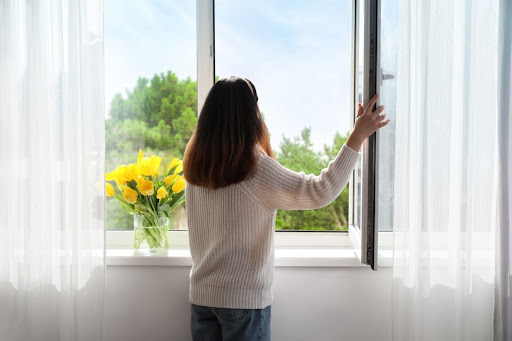As flowers bloom and the outdoor air fills with the fresh scents of spring, many of us open our windows to let the seasonal change refresh our homes. However, with spring also comes an increase in allergens like pollen, and suddenly, our indoor air quality can start to affect our comfort and health. If you’re one of the many people who notice a spike in sneezes, coughs, or watery eyes during this time, you’re not alone. Improving the air quality in your home might be the relief you need.
In this blog, we’ll review five effective tips to improve indoor air quality this spring!
What Causes Poor Indoor Air Quality in Spring?
Springtime is often marked by a rise in allergens like pollen, dust, and pet dander, which can infiltrate our homes. Compounding the problem, prolonged winter months often mean our houses have been sealed against the cold, trapping stale air and pollutants indoors. This combination can lead to a spike in indoor air pollution, exacerbating allergies and other respiratory conditions.
Moreover, common household activities such as painting, cleaning, or even cooking can release additional pollutants like volatile organic compounds (VOCs), carbon monoxide, and other harmful chemicals into your indoor environment. Recognizing these sources is the first step toward mitigating their impact on your indoor air quality.
Tips to Improve Indoor Air Quality
As we welcome the joys of spring, it’s important to take some time to think about the air inside your home. By following these helpful tips to improve indoor air quality, you can create a healthier, more pleasant living environment.
Maintain Your Air Conditioning and Ventilation Systems
Do you want to learn how to improve indoor air quality? It’s best to start with the basics. For instance, one of the most beneficial ways to improve indoor air quality is to check your systems. You’ll want to make sure that your air conditioning systems and other ventilation systems are in top working order.
A well-maintained HVAC system with clean filters can drastically reduce the presence of indoor air pollutants. Replacing or cleaning air filters regularly improves air quality and enhances the efficiency of your systems, which can potentially reduce your energy costs.
Use Air Purifiers and Humidifiers
Investing in an air purifier can improve the air quality in your home by removing smaller particles and allergens that typical air filters may miss. HEPA filters, in particular, are known for their efficiency in trapping airborne particles, including pollen, dust mites, and mold spores.
Additionally, maintaining a balanced humidity level indoors can inhibit the growth of mold and dust mites, common allergens that thrive in high-humidity environments. Humidifiers and dehumidifiers can help maintain an optimal indoor humidity level, making the air more comfortable and healthier to breathe.
Embrace Fresh Air
Regularly opening windows to let in fresh air can dramatically improve overall air quality. This practice helps to clear out stale air and reduce the concentration of indoor pollutants. However, be mindful of local outdoor air quality and pollen counts — keep windows closed on days when outdoor air quality is poor or when pollen levels are high.
Indoor plants can also play a role in improving indoor air quality. Plants such as spider plants, peace lilies, and snake plants are not only aesthetically pleasing but also naturally clean the air by absorbing toxins and producing oxygen.
Implement Source Control of Pollutants
Minimize the use of products that release harmful chemicals into the air. Opt for natural or environmentally friendly cleaning products that do not emit VOCs. Additionally, be cautious with the use of air fresheners and candles, which can also release pollutants.
If you have a gas stove, verify that it is well-ventilated to minimize the emission of nitrogen dioxide and carbon monoxide. Regular cleaning and maintenance of all cooking and heating appliances will also reduce the release of pollutants into your home.
Conduct Regular Cleanings
Regular cleaning can remove dust, pet dander, and other allergens from your home environment. Vacuuming carpets and rugs at least twice a week with a vacuum equipped with a HEPA filter can capture a significant amount of dust and allergens from the floor surfaces. Similarly, regularly washing bedding, drapes, and other fabrics can help reduce allergens in the home.
Keep areas prone to dampness, such as bathrooms and basements, clean and dry to prevent mold growth, which is a major indoor allergen and irritant.
Breathe Easy This Spring With Quality Heating & Cooling!
Improving the indoor air quality of your home doesn’t have to be a daunting task. By implementing these tips to improve indoor air quality, you can create a healthier and more comfortable living environment. Remember, each small step can lead to significant benefits for the air you breathe at home.
Ready to breathe easier this spring? For those looking to upgrade their air quality or require routine maintenance for their AC system, consider Quality Heating & Cooling. Whether you need help enhancing your indoor air quality or need a reliable air conditioning service in Canton, OH, our team is here to help you make your home a sanctuary for clean, fresh air.
Now that you know how to improve indoor air quality, why wait to give us a call? Schedule a service today and breathe easier tomorrow. Contact us today to enhance your air quality in North Canton or one of the surrounding communities!


